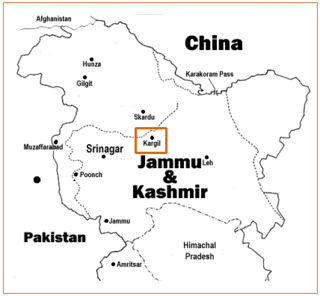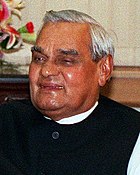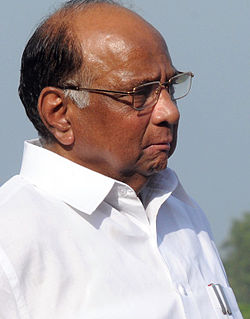The politics of India takes place within the framework of the country's constitution. India is a federal parliamentary democratic republic in which the President of India is the head of state and the Prime Minister of India is the head of government. India follows the dual polity system, i.e. a double government that consists of the central authority at the centre and states at the periphery. The constitution defines the organisational powers and limitations of both central and state governments, and it is well-recognised, rigid and considered supreme; i.e. the laws of the nation must conform to it.

Lal Krishna Advani is an Indian politician who served as the 7th Deputy Prime Minister of India from 2002 to 2004 under Atal Bihari Vajpayee. He is one of the co-founders and a senior leader of the Bharatiya Janata Party. Advani also served as Minister of Home Affairs in the BJP-led National Democratic Alliance government from 1998 to 2004. He was the Leader of the Opposition in the 10th Lok Sabha and 14th Lok Sabha. He was the National Democratic Alliance prime ministerial candidate in the 2009 general elections.

Rahul Gandhipronunciation (help·info)[ˈraːɦʊl ˈɡaːnd̪ʱiː] is an Indian politician. He hails from a long line of politicians, known as the Nehru-Gandhi family, which has occupied a prominent place in the politics of India ever since the country gained independence in 1947. His great-grandfather was Jawaharlal Nehru, the first prime minister of India and also the longest serving Prime Minister of India having served for a total of seventeen years. Gandhi's grandmother Indira was the first woman Prime Minister of India and his father Rajiv Gandhi was the youngest prime minister of India to be sworn in to office. The son of Sonia and Rajiv Gandhi, he is the President of the Indian National Congress and serves such additional offices as the Chairperson of the Indian Youth Congress and the National Students Union of India. A member of the Indian Parliament, Gandhi represents the constituency of Amethi, Uttar Pradesh in the 16th Lok Sabha.
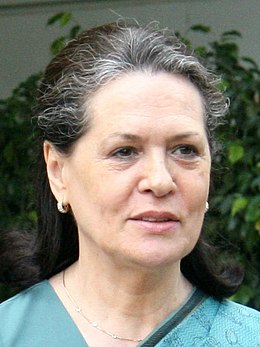
Legislative elections were held in India in four phases between 20 April and 10 May 2004. Over 670 million people were eligible to vote, electing 543 members of the 14th Lok Sabha. The Lok Sabha, or "House of the People," is the directly elected lower house of the Parliament of India.
United Progressive Alliance (UPA) is a coalition of centre-left political parties in India formed after the 2004 general election. The largest member party of the UPA is the INC, whose Former National President Sonia Gandhi is chairperson of the UPA. It formed a government with support from some other left-aligned parties in 2004.
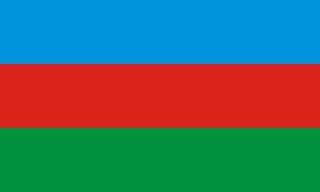
The Lok Janshakti Party (LJP) is a state political party in the state of Bihar, India. It is led by Ram Vilas Paswan. The party was formed in 2000 when Paswan split from Janata Dal (United). The party has considerable following amongst Dalits in Bihar. Currently the party is a member of the National Democratic Alliance.

India held general elections to the 15th Lok Sabha in five phases between 16 April 2009 and 13 May 2009. With an electorate of 714 million, it was the largest democratic election in the world till the Indian General Elections 2014 held from 7 April 2014.

General elections were held in India in 1996 to elect the members of the 11th Lok Sabha contested by the Congress Party and Bharatiya Janata Party. The result of the election was a hung parliament with neither top two leading securing a mandate. The Bharatiya Janata Party formed a short lived government. United Front, consisting of non Congress, non BJP was created and secured support from 332 members out of the 545 seats in the Lok Sabha, resulting in H.D. Deve Gowda from the Janata Dal being the 11th Prime Minister of India. The 11th Lok Sabha produced three Prime Ministers in two years and forced the country back to the polls in 1998.

The Indian general election, 2014 was held to constitute the 16th Lok Sabha, electing members of parliament for all 543 parliamentary constituencies. Running in nine phases from 7 April to 12 May 2014, it was the longest election in the country's history. According to the Election Commission of India, 814.5 million people were eligible to vote, with an increase of 100 million voters since the last general election in 2009, making it the largest ever election in the world. Around 23.1 million or 2.7% of the total eligible voters were aged 18–19 years. A total of 8,251 candidates contested for the 543 Lok Sabha seats. The average election turnout over all nine phases was around 66.38%, the highest ever in the history of Indian general elections.

The Indian general election, 1998 polls in Tamil Nadu were held for 39 seats in the state. New elections were called when Indian National Congress (INC) left the United Front government led by I.K. Gujral, after they refused to drop the regional Dravida Munnetra Kazhagam (DMK) party from the government after the DMK was linked by an investigative panel to Sri Lankan separatists blamed for the killing of Rajiv Gandhi. The result was a landslide victory for the National Democratic Alliance (NDA) winning 29 seats, which helped result in Atal Bihari Vajpayee being sworn in as the 16th Prime Minister of India. J. Jayalalithaa and the Anna Dravida Munnetra Kazhagam, broke off from their long alliance with Indian National Congress and formed an alliance with Bharatiya Janata Party, by joining the National Democratic Alliance. This state proved to be very important in determining the prime minister, since the 18 seats of ADMK proved valuable for BJP to hold power. That was short-lived, since the ADMK left the alliance in less than a year, and BJP lost the vote of confidence resulting in fresh elections being called.

Elections in Tamil Nadu are conducted every five years to elect the State assembly and its share of members to the Lok Sabha. There are 234 assembly constituencies and 39 Lok Sabha constituencies. The state has conducted 15 assembly elections and 16 Lok Sabha elections since independence.
Atal Bihari Vajpayee was three time Prime Minister of India, first from 16 May to 1 June 1996, and then from 19 March 1998 to 22 May 2004. A member of the Bharatiya Janata Party (BJP), Vajpayee served as the eleventh Prime Minister of India. He headed the BJP-led National Democratic Alliance in the Indian Parliament, and became the first Prime Minister unaffiliated with the Indian National Congress to complete a full five-year term in office. He died at the age of 93 on Thursday 16 August 2018 at 17:05 at AIIMS, New Delhi.

The 2019 Indian general election is scheduled to be held in seven phases from 11 April to 19 May 2019 to constitute the 17th Lok Sabha. The counting of votes will be conducted on 23 May, and on the same day the results will be declared.
Conservatism in India refers to the political philosophy of conservatism as it has developed in India. Politics in India has since at least the 1990s been most predominantly a contest between the centre-left Indian National Congress alliance and the center-right Bharatiya Janata Party.


